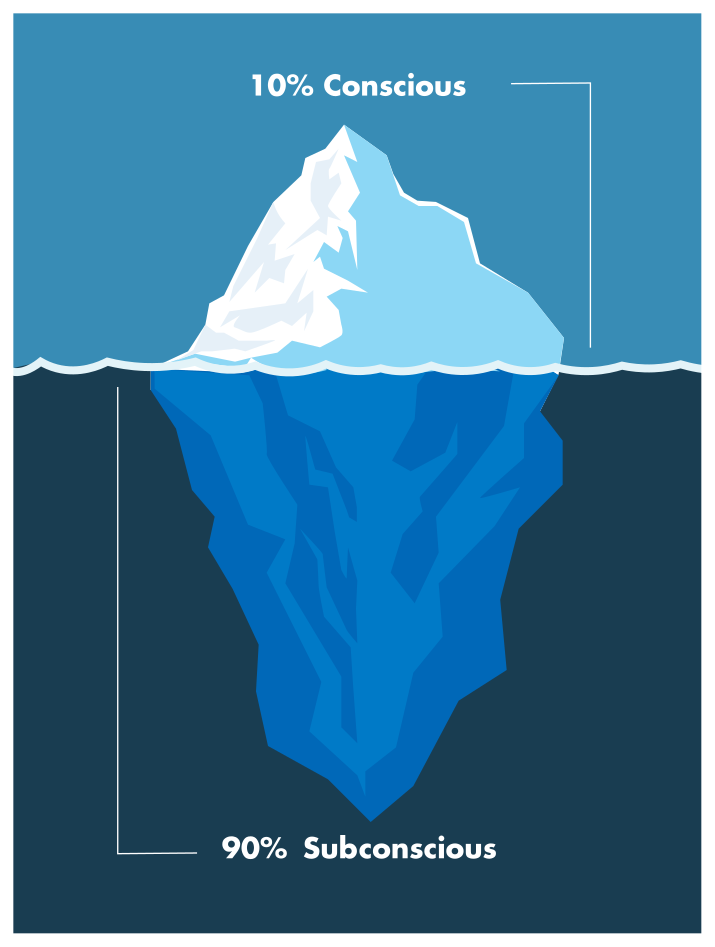Hypnotherapy
What is hypnosis?
Hypnosis is sometimes referred to as a relaxed state of consciousness in which an individual can experience an increased receptiveness and responsiveness to their inner sensed perceptions. It is a state of heightened suggestibility in which a therapist can use suggestions to influence the client’s subconscious mind while their conscious mind remains relaxed. This therapeutic change is brought about with the cooperation of the client who is in control at all times. The client can choose to return to full alertness at any time.
The conscious and subconscious mind
The Conscious Mind
The analogy of the iceberg is often used as a comparison to distinguish the parts of the mind and how they work together. Above the surface of the water is the conscious mind, the smaller part of the mind that is associated with rational thinking, decision-making, analysing and the forming of judgements. It actively sorts and filters what is perceived but its capacity is restricted. Everything else that it is unable to process falls below the water-line, into the subconscious mind.
Iceberg analogy of conscious & subconscious mind
The Subconscious Mind
The subconscious mind acts as a support network of resources for the conscious mind. Once you have overcome the conscious learning stages in activities such as walking, driving or cycling, they then become automatic (subconscious). These various skills are then directed by the subconscious mind. For example, on a regular journey, we can commute to work without being consciously aware of how we have integrated these complex processes into “one” skill – driving (or cycling). Our conscious mind is still responsible for filtering the important information such as stopping at the red light or avoiding an obstacle. But the subconscious mind is coordinating all of these once difficult ‘mini’ skills into an automatic pattern of events.
The Imagination
The imagination sits at the surface of the water. It is the communication link between both parts of the mind, restoring vital information from the subconscious mind up into the conscious mind when it is needed. In relaxed conversation, memories of topics being discussed pop up into our awareness, improving the quality of our dialogue. New ideas, daydreams and intuition are all part of the flow of traffic from the subconscious mind, up into the conscious mind.
Positive and Negative Communications
This communication can be two-way. With the imagination, the conscious mind can communicate downwards into the subconscious mind through the use of suggestions about what it wants. By imagining these goals, events, feelings, dialogue or situations etc. in the most positive way possible, the subconscious mind can act to make them happen and become your reality.
However, the imagination can also cause the conscious mind to communicate unwanted responses to negative events to the subconscious mind which may cause a spiral of negative feelings and emotions, anxiety and thoughts of self-worthlessness.
Benefit of Hypnosis
Referring back to the iceberg metaphor, hypnosis creates a relaxed state of mind that bypasses the tip of the iceberg. This part of our mind, that actively sorts and filters information, is still awake and watchful but is in a more restful state. The subconscious mind, or the part that is beneath the surface of the water, becomes more accessible and more receptive to communication without interference from the conscious mind. Having previously discussed the outcomes and built rapport with the client, the hypnotherapist can then help direct the client towards these goals without conscious judgement. For the client, they can once again re-educate mind and body back into that positive state, without influence from any negative conflicts, due to the hypnosis.
What is Hypnotherapy?
Hypnotherapy is the therapeutic use of hypnosis, with the aim of introducing a long-term beneficial change. It can help to create a valuable change in a client’s thoughts, beliefs, values, feelings and behaviour.
Whilst the client remains in control, a variety of strategies can be used to treat the symptoms.
Suggestion therapy
Suggestion therapy is the use of suggestions which will continue to affect the clients feelings, thoughts and behaviours when the hypnotic state has ended. This is frequently an effective method of handling habits such as smoking or exam nerves. It is often possible to see positive changes within a low number of sessions, sometimes one or two.
Analytical hypnotherapy
Analytical hypnotherapy (also known as hypno-analysis) is another method of providing treatment aimed at identifying the underlying reason for a presenting problem. This may involve the identification of suppressed causes which need to be addressed. Working though the causes can help to make the symptom become redundant. It can be used to treat problems with a more complex background. As this type of therapy is used for more complex cases it usually requires a greater number of sessions.


